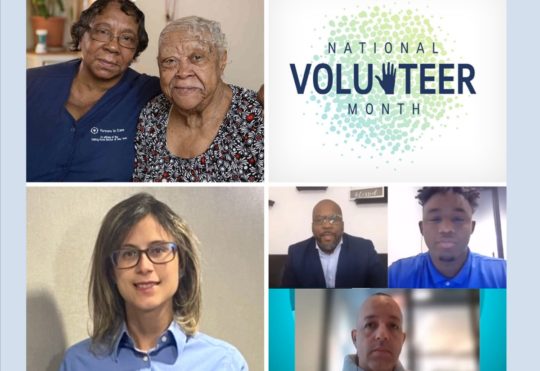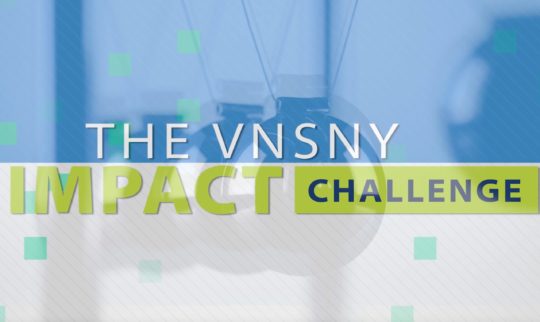How VNSNY’s Education Department Innovated to Train and Support Staff During the Pandemic
As the COVID-19 pandemic hit the New York metropolitan area last March, VNSNY’s Education Department had to leap to the occasion and find a way to continue providing training and support to VNSNY staff in an environment where social distancing and infection control were suddenly paramount.
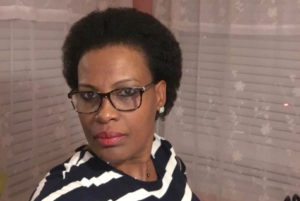 “Having to move on a dime and begin educating virtually in such a short turnaround time was a challenge,” says Elizer Cooper-Audain, Director of Education & Professional Development, Clinical Support Services. “My entire team did an amazing job in response to COVID-19. We were in the last week of our March orientation when we had to pack up and prepare to work remotely. We completed the orientation virtually, and then prepared for subsequent months of new hire orientation, as well as the new nurse resident program.”
“Having to move on a dime and begin educating virtually in such a short turnaround time was a challenge,” says Elizer Cooper-Audain, Director of Education & Professional Development, Clinical Support Services. “My entire team did an amazing job in response to COVID-19. We were in the last week of our March orientation when we had to pack up and prepare to work remotely. We completed the orientation virtually, and then prepared for subsequent months of new hire orientation, as well as the new nurse resident program.”
Accomplishing all this, Elizer adds, involved “setting up virtual orientation, training everyone on how to use the platform and the equipment, and basically stepping up all around. Everyone was agile, flexible, and really demonstrated teamwork, all without complaining. Many had personal family and friends affected by COVID-19, yet they kept going. I am honored to work with the men and women of the education team.”
 The challenge of creating a virtual orientation fell to Paul Vandeyar, Education Project Manager. Besides training presenters on the platform—first Webex and later Zoom, which was found to be more stable and user-friendly—much work had to be done resolving connection issues and other glitches as well as conducting prior test sessions with presenters and participants.
The challenge of creating a virtual orientation fell to Paul Vandeyar, Education Project Manager. Besides training presenters on the platform—first Webex and later Zoom, which was found to be more stable and user-friendly—much work had to be done resolving connection issues and other glitches as well as conducting prior test sessions with presenters and participants.
After getting the new orientation process up and running in record time, Paul and the team were pleased to find that the virtual approach also had a number of advantages. “Many of the new remote features, like the ability to complete all kinds of critical paperwork using DocuSign, have streamlined orientation, making it very cohesive, with a lot less time wasted filling out HR and Skills Lab forms,” says Paul. He also leads breakout rooms during the Zoom sessions, in which smaller groups of webinar participants can meet separately to focus on targeted topics.
 “I think the virtual technology has opened people’s minds to alternative ways of learning,” says Education Manager Michael Gloria, who helped lead VNSNY’s COVID-19 response in terms of updating the electronic medical record system for VNSNY Home Care. “Nothing’s going to replace face-to-face interaction. Still, while there were challenges and sometimes a huge learning curve, we were able to effectively meet our education responsibilities despite the crisis. I hope we continue to think outside of the box, as we did here.”
“I think the virtual technology has opened people’s minds to alternative ways of learning,” says Education Manager Michael Gloria, who helped lead VNSNY’s COVID-19 response in terms of updating the electronic medical record system for VNSNY Home Care. “Nothing’s going to replace face-to-face interaction. Still, while there were challenges and sometimes a huge learning curve, we were able to effectively meet our education responsibilities despite the crisis. I hope we continue to think outside of the box, as we did here.”
 Keeping participants engaged during online sessions is also key to effective virtual learning, notes Alice Rainford-Miller, Education Manager in charge of the Nurse Residency training program. “I tailored our presentations to grab participants’ attention, by going around the room to learn about everybody and also integrating lots of questions and even games like clinical Jeopardy! and clinical Word Find,” says Alice. While wound management and other complex, critical skills are still taught face-to-face using mannequins with strict social distancing in place, she adds, other skills like hand-washing are easily taught remotely. “We’ve proven we can successfully run classrooms virtually, and we’ll continue to build on that skill and technology.”
Keeping participants engaged during online sessions is also key to effective virtual learning, notes Alice Rainford-Miller, Education Manager in charge of the Nurse Residency training program. “I tailored our presentations to grab participants’ attention, by going around the room to learn about everybody and also integrating lots of questions and even games like clinical Jeopardy! and clinical Word Find,” says Alice. While wound management and other complex, critical skills are still taught face-to-face using mannequins with strict social distancing in place, she adds, other skills like hand-washing are easily taught remotely. “We’ve proven we can successfully run classrooms virtually, and we’ll continue to build on that skill and technology.”
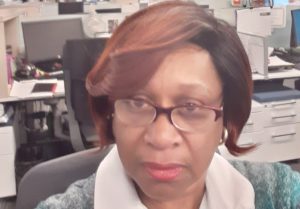 In addition to these new formats, the pandemic has also impacted VNSNY’s educational content. “Orientation is not only training nurses for the field, it’s also preparing them for a world with COVID-19,” says Peggy Osei-Tutu, Education Manager for Workforce Investment Organization (WIO) care management and VNSNY’s Nurse Residency program. “One of the things we created was a mandatory PPE competency skills tool to educate nurses on how to use the equipment correctly when they went into patients’ homes.” To supplement the training, Peggy and nurse Gale Halley manned a PPE phone line to answer clinicians’ questions.
In addition to these new formats, the pandemic has also impacted VNSNY’s educational content. “Orientation is not only training nurses for the field, it’s also preparing them for a world with COVID-19,” says Peggy Osei-Tutu, Education Manager for Workforce Investment Organization (WIO) care management and VNSNY’s Nurse Residency program. “One of the things we created was a mandatory PPE competency skills tool to educate nurses on how to use the equipment correctly when they went into patients’ homes.” To supplement the training, Peggy and nurse Gale Halley manned a PPE phone line to answer clinicians’ questions.
Another plus is that the remote training model allows staff to receive critical COVID-19 updates instantly. “When the pediatric inflammatory syndrome was identified, we created a communication cloud so that nurses in the field would know what to look for and could educate their clients with children,” says Peggy.
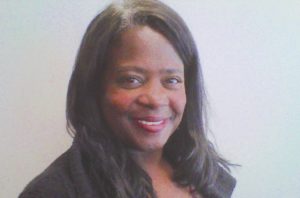 Education around VNSNY’s Hospitalization at Home (HAH) collaboration with Mount Sinai Health System and Contessa Health was also expanded. The HAH program trains nurses to provide intensive home care to recently discharged ER patients—a particularly valuable service during a pandemic. “These highly skilled nurses are able to provide care for acutely ill ER patients in the safety of the patients’ own homes,” says Deborah Wilson, a Basic Life Support (BLS) instructor and nurse educator with HAH.
Education around VNSNY’s Hospitalization at Home (HAH) collaboration with Mount Sinai Health System and Contessa Health was also expanded. The HAH program trains nurses to provide intensive home care to recently discharged ER patients—a particularly valuable service during a pandemic. “These highly skilled nurses are able to provide care for acutely ill ER patients in the safety of the patients’ own homes,” says Deborah Wilson, a Basic Life Support (BLS) instructor and nurse educator with HAH.
Because of the advanced training in infusion and other skills that is required, in-person training remained an important component of Hospitalization at Home, even during the pandemic, which meant the program’s trainers had to innovate. “After getting permission to go into the office and ensuring that conditions were safe, we brought in clinicians in different groups so that they could practice the skills and get BLS certified,” adds Deborah. “Arranging the logistics in such short time was a challenge—going from borough to borough carrying all the arms, legs, and other BLS equipment needed for the all-day sessions.”
Deborah also expresses special thanks to Marvin Siegel, VNSNY’s Regional Clinical Manager of Infusion Care, and Alisa Gadson nurse manager for Contessa Health-Mount Sinai Hospitalization at Home, for sharing their IV expertise as part of the training, and to VNSNY Education Manager Laudz Cheriel-Burke, who stepped in to assist with onsite training.
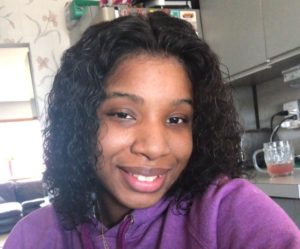 Many Education staff members stepped outside of their usual roles to support VNSNY’s COVID-19 response. Sade Oyebode, an administrative assistant for WIO and the Nurse Residency program, pitched in several days a week at the Nassau supply room, handing out PPE to clinicians—all while continuing to perform her regular job from home. “I prepared the admissions charts and other forms that needed to be placed in the clinicians’ folders, and made sure that they had the proper garments, gloves, N95 masks and shoes,” she says. “It was a little hectic at first, because I had to learn where everything was. On top of that, there were frequent changes in the protocols to accommodate clinicians’ specific needs. It was a good experience, though. Everyone was very nice and helpful—and it was great to get out of the house!”
Many Education staff members stepped outside of their usual roles to support VNSNY’s COVID-19 response. Sade Oyebode, an administrative assistant for WIO and the Nurse Residency program, pitched in several days a week at the Nassau supply room, handing out PPE to clinicians—all while continuing to perform her regular job from home. “I prepared the admissions charts and other forms that needed to be placed in the clinicians’ folders, and made sure that they had the proper garments, gloves, N95 masks and shoes,” she says. “It was a little hectic at first, because I had to learn where everything was. On top of that, there were frequent changes in the protocols to accommodate clinicians’ specific needs. It was a good experience, though. Everyone was very nice and helpful—and it was great to get out of the house!”
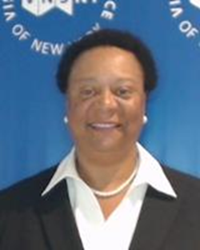 Doreen Joseph, also an administrative assistant in the Education Department, still helps out in the Manhattan medical supply room two days a week. “Stepping inside the office was scary at the beginning. None of us had been down this road before, and I was running on a lot of adrenaline back then,” she says. “What’s important to keep in mind is that we’re all in this together—the whole world is in the same predicament. I try to remain positive and to be ready for everything. I picture all of us going forward, like a human link.”
Doreen Joseph, also an administrative assistant in the Education Department, still helps out in the Manhattan medical supply room two days a week. “Stepping inside the office was scary at the beginning. None of us had been down this road before, and I was running on a lot of adrenaline back then,” she says. “What’s important to keep in mind is that we’re all in this together—the whole world is in the same predicament. I try to remain positive and to be ready for everything. I picture all of us going forward, like a human link.”
To read more VNSNY Heroes of 2020 articles, please click here.
